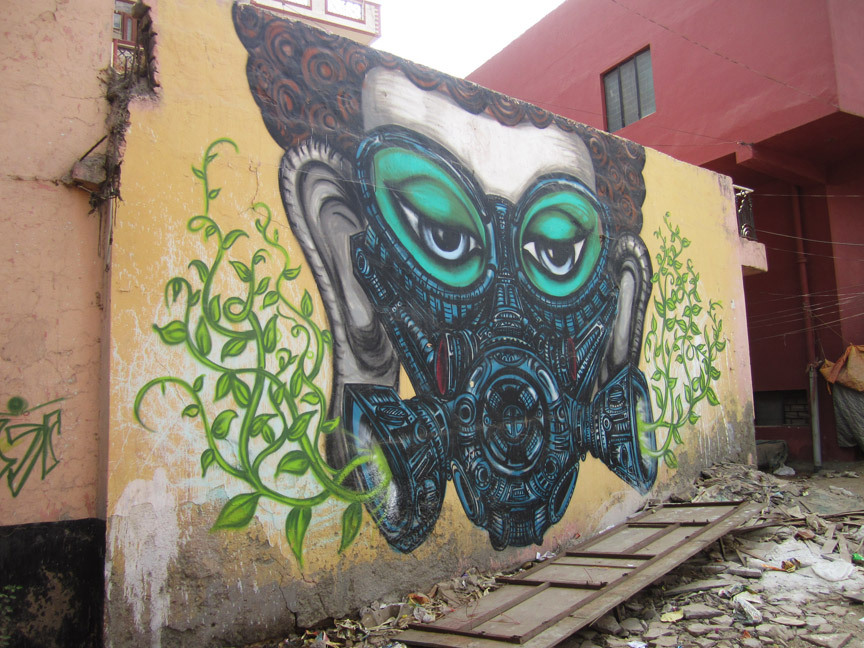This mural of a Buddha-like face covered in a gas mask sprouting leaves, by artist Yantr, faces a heavily congested intersection in Khirki village. Used as a thoroughfare to get to a major shopping mall near the village, it is known for being a particularly polluted spot located between the urban and the semi-rural.
Here is one of Khirki Village’s inner alleyways, replete with street-side cooking, two-wheeled forms of transport and chaotic, electrical wiring.
French curator Flora Boillot wanted to create a multi-colored, pixilated effect with this mural, to reflect the various brightly colored plastic bags that lay beneath it in the rubbish dump. The smoke from the burning refuse, as well as the toilet seat, are later additions to the site.
The red and grey angel on a road-side pillar was stenciled and painted by visual artist and production designer duo, Siddhartha Mathawan and Sandra Pfeil.
It was nine pm on a week day. Amitabh Kumar was coming back from work and saw his artist friend Akshay Rathore painting a lizard onto the side of a dhaba (road-side restaurant) wall. Taken by the drawing, Amitabh opted to join Akshay and help him. The pair soon attracted the attention of a local laborer, who had been working as a painter, and challenged them that he would do a better, faster job. The piece was thus completed overnight.
A boy walks past the design motifs of a living room painted on a wall, and somebody’s actual living room with two men sitting on the sofa.
Siddhartha Mathawan and Sandra Pfeil spent three days speaking to the residents near this corridor-like space, before they eventually created several murals with wallpaper patterns, images of hanging photographs and mantelpieces with ornaments.
The reflection of a barber cutting a man’s hair with the living room “set” behind him.
Namaste (2012) by Siddhartha Mathawan and Sandra Pfeil.
Route Cat (2012) by Anpu Varkey was the mascot of the street art festival and marked the fact that there was a mural nearby.
Another Route Cat, scratched over time.
These two giant squids facing in opposite directions look on to the village and the mall simultaneously.
Italian street artist Mattia Lullini surprised Khirki residents with his technique of painting with a brush strapped to two curtain rods. Over time he became good friends with the people that lived in this building; they encouraged him and stored his supplies as he worked. The building will be demolished soon.
Children playing in the car-lined streets of Khirki village.
A double-headed, purple creature with arms splayed, painted above the entrance of somebody’s home, by the collective Illusion in Motion.
Known for tagging in Hauz Khas village (and for his family’s background in antiquities), Vinay Khavadiya has painted the entire side of this house.
Vinay Khavadiya’s quirky, tribal mural juxtaposed with a traditional print of the gods Lakshmi, Ganesh and Saraswati.
Artist Amitabh Kumar checks the guide map showing the positions of all the murals, as he guides me around Khirki’s dense maze of streets and alleyways.
Owls (2012) by graphic designer and illustrator Mayank Rai—later partially covered by a political campaign poster depicting Sonia and Rahul Gandhi.
A man in traditional village attire walking past a mural by graffiti artist Zine.
Zine, along with He Ra, is part of the collective Slumgods, who run a hip-hop dance studio in Khirki called Tiny Drops.
A man checks his notebook as he delivers milk and yoghurt to the neighborhood, next to a mural by Mattia Lullini.
This is one of the largest murals in the village, a collaborative work by Anpu Varkey and Mattia Lullini. The space is now used as a car park and a refuse area.
Bicycles next to chickens, next to scooters, in Khirki Village.
Graphic artist and comic-book designer Amitabh Kumar took five days in early March to complete The Flight of the Hippo-Froggy (2012). The idea for this mural came about after he painted Inside the Hippo-Froggy (2012) (see the next image), also for the festival.
Amitabh Kumar’s piece Inside the Hippo-Froggy shows a fly, carrying a mouse, carrying a generator. It was one of the first murals painted as part of this festival and as such fascinated the local children who kept asking “What does it mean?” or ”What is its message?” To which Amitabh replied: “Why don’t you create a new message for yourself every day? As you will be living with it longer than me.”
The children still didn’t leave Amitabh alone, so he gave them his extra paints and told them to use them. At first they painted their names and phone numbers, but as they saw Amitabh’s work evolve they began to experiment and gain confidence. The Muscle Man was painted by about a dozen boys aged 10 to 16, at 11:30 at night.
Illusion in Motion is by the eponymous collective consisting of architect Shayanathan Mitra, with G2 and Pin 2. They are all part of the production team behind public arts festivals such as 48 Degrees (which took place in 2008) in Delhi and the recent Yamuna-Elbe project (2012).




